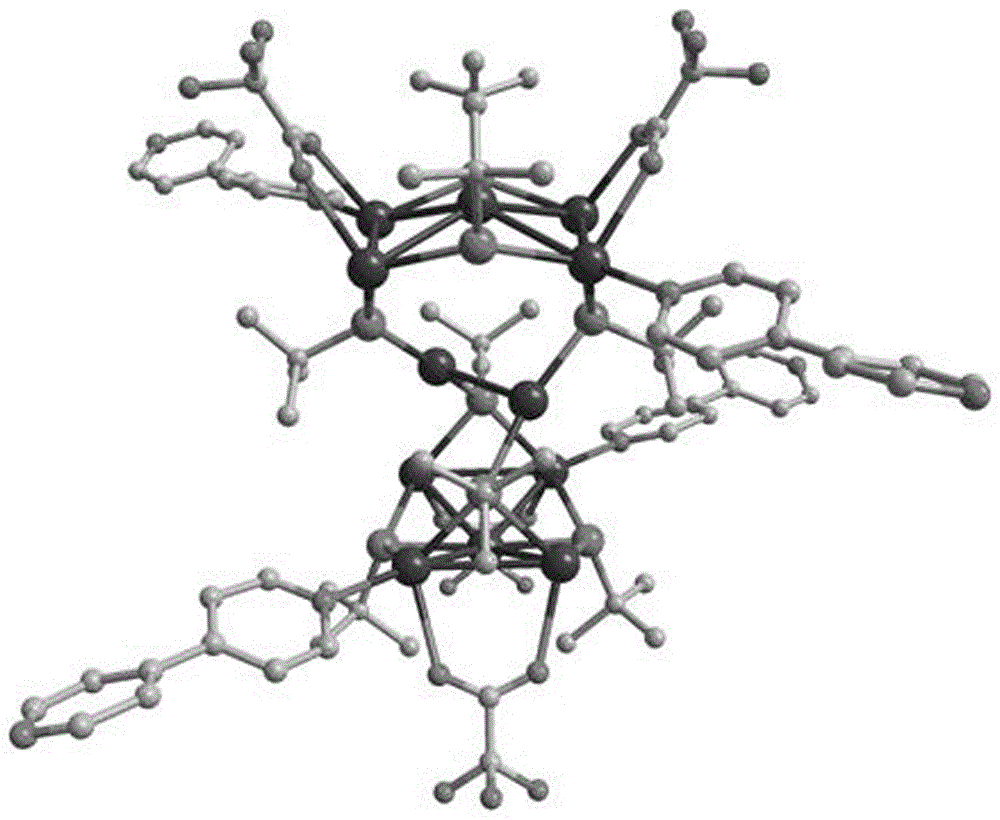Application of sulfydryl silver cluster coordination polymer in organic solvent detection
A technology of coordination polymers and organic solvents, which is applied in the cross field of nanomaterials and coordination chemistry, can solve the problems of harmfulness to human body and strong carcinogenicity, and achieve the effects of long detection life, good promotion value and low cost
- Summary
- Abstract
- Description
- Claims
- Application Information
AI Technical Summary
Problems solved by technology
Method used
Image
Examples
Embodiment 1
[0025] Embodiment 1: the synthesis of polymer material of the present invention
[0026] 0.338mL (3mmol) tert-butyl mercaptan (Bu t SH) was dissolved in a mixed solution of 15mL acetonitrile and 15mL ethanol, and stirred rapidly; adding 0.9g (4mmol) silver trifluoroacetate (CF 3 COOAg), stirred until the solution was clear; then added trifluoroacetic acid to adjust the pH to 2–3, and finally added 0.5 g (3 mmol) of 4,4’-bipyridine (bpy), and continued to stir for 10 minutes. After the reaction, the solution was evaporated at room temperature in the dark, and about 1 g of colorless massive crystals was obtained after 3 days, with a yield of 75%. After filtering, washing with ethanol, and drying at room temperature, an organic solvent-induced fluorescent color-changing material was obtained. Its porosity is 21.64%.
Embodiment 2
[0027] Embodiment 2: The polymer material of the present invention recognizes and detects organic solvents
[0028] Taking the polymer material sample of the present invention prepared in Example 1, under the irradiation of a 365nm ultraviolet lamp, organic solvents of different polarities were added dropwise to the material, and the fluorescent color of the material changed from bright green to orange red. from Image 6 with 7 It can be seen that this material can be recognized by naked eyes in the detection of organic solvents.
Embodiment 3
[0029] Embodiment 3: polymer organic solvent identification fluorescence spectrometry of the present invention
[0030] Take 20 mg of the polymer powder sample of the present invention prepared in Example 1, put it into a solid sample tank for fluorescence testing, add 30 μL of organic solvent dropwise on the sample (wet the material completely), and measure its fluorescence spectrum (excitation wavelength 365nm). The maximum fluorescence emission peak wavelength of the polymer material of the present invention red shifts with the increase of solvent polarity. and the E of the organic solvent T The value of (30) has a linear relationship with the fluorescence maximum emission wavelength of the polymer material containing the present invention. After the organic solvent in the sample evaporates to dryness, measure its solvent-free fluorescence spectrum. In this way, in the cycle of adding solvent and volatilizing solvent, measure its fluorescence spectrum to prove its stabili...
PUM
 Login to View More
Login to View More Abstract
Description
Claims
Application Information
 Login to View More
Login to View More - R&D
- Intellectual Property
- Life Sciences
- Materials
- Tech Scout
- Unparalleled Data Quality
- Higher Quality Content
- 60% Fewer Hallucinations
Browse by: Latest US Patents, China's latest patents, Technical Efficacy Thesaurus, Application Domain, Technology Topic, Popular Technical Reports.
© 2025 PatSnap. All rights reserved.Legal|Privacy policy|Modern Slavery Act Transparency Statement|Sitemap|About US| Contact US: help@patsnap.com



